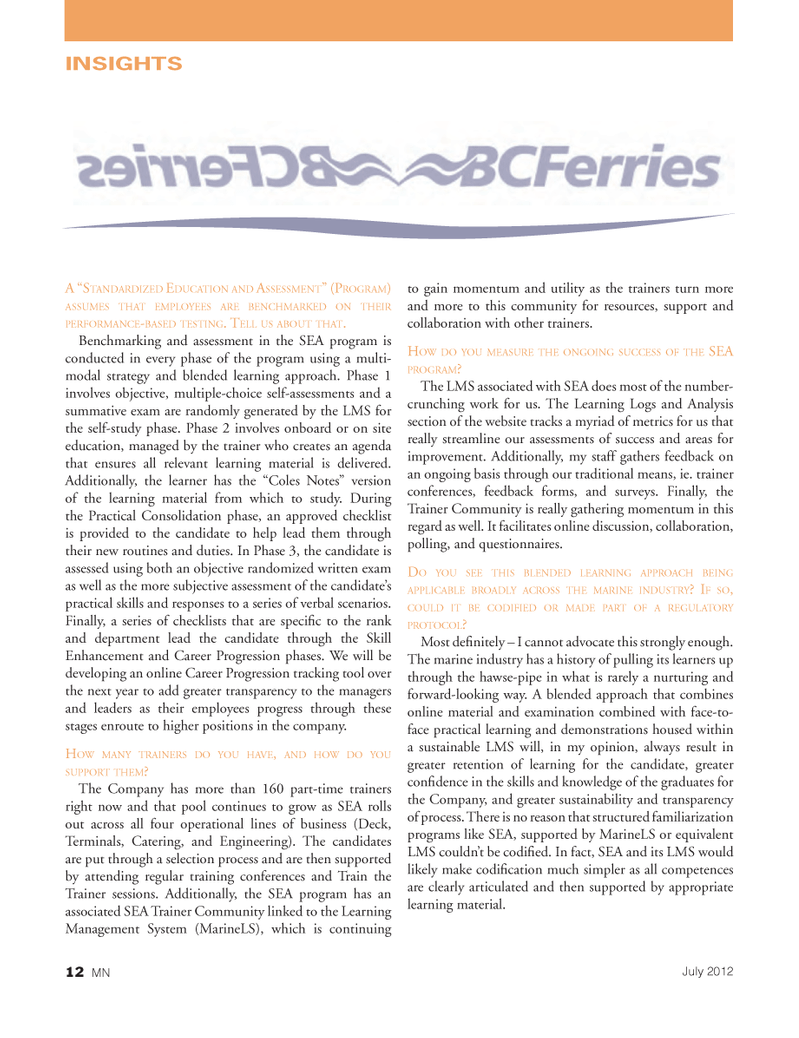
Page 12: of Marine News Magazine (July 2012)
Propulsion Technology
Read this page in Pdf, Flash or Html5 edition of July 2012 Marine News Magazine
INSIGHTSA ?STANDARDIZED EDUCATION AND ASSESSMENT? (PROGRAM ) ASSUMES THAT EMPLOYEES ARE BENCHMARKED ON THEIR PERFORMANCE -BASED TESTING. TELL US ABOUT THAT . Benchmarking and assessment in the SEA program is conducted in every phase of the program using a multi- modal strategy and blended learning approach. Phase 1 involves objective, multiple-choice self-assessments and a summative exam are randomly generated by the LMS for the self-study phase. Phase 2 involves onboard or on site education, managed by the trainer who creates an agenda that ensures all relevant learning material is delivered. Additionally, the learner has the ?Coles Notes? version of the learning material from which to study. During the Practical Consolidation phase, an approved checklist is provided to the candidate to help lead them through their new routines and duties. In Phase 3, the candidate is assessed using both an objective randomized written exam as well as the more subjective assessment of the candidate?s practical skills and responses to a series of verbal scenarios. Finally, a series of checklists that are speci c to the rank and department lead the candidate through the Skill Enhancement and Career Progression phases. We will be developing an online Career Progression tracking tool over the next year to add greater transparency to the managers and leaders as their employees progress through these stages enroute to higher positions in the company. HOW MANY TRAINERS DO YOU HAVE , AND HOW DO YOU SUPPORT THEM? The Company has more than 160 part-time trainers right now and that pool continues to grow as SEA rolls out across all four operational lines of business (Deck, Terminals, Catering, and Engineering). The candidates are put through a selection process and are then supported by attending regular training conferences and Train the Trainer sessions. Additionally, the SEA program has an associated SEA Trainer Community linked to the Learning Management System (MarineLS), which is continuing to gain momentum and utility as the trainers turn more and more to this community for resources, support and collaboration with other trainers.HOW DO YOU MEASURE THE ONGOING SUCCESS OF THE SEA PROGRAM ? The LMS associated with SEA does most of the number-crunching work for us. The Learning Logs and Analysis section of the website tracks a myriad of metrics for us that really streamline our assessments of success and areas for improvement. Additionally, my staff gathers feedback on an ongoing basis through our traditional means, ie. trainer conferences, feedback forms, and surveys. Finally, the Trainer Community is really gathering momentum in this regard as well. It facilitates online discussion, collaboration, polling, and questionnaires. DO YOU SEE THIS BLENDED LEARNING APPROACH BEING APPLICABLE BROADLY ACROSS THE MARINE INDUSTRY ? IF SO, COULD IT BE CODIFIED OR MADE PART OF A REGULATORY PROTOCOL ? Most de nitely ? I cannot advocate this strongly enough. The marine industry has a history of pulling its learners up through the hawse-pipe in what is rarely a nurturing and forward-looking way. A blended approach that combines online material and examination combined with face-to-face practical learning and demonstrations housed within a sustainable LMS will, in my opinion, always result in greater retention of learning for the candidate, greater con dence in the skills and knowledge of the graduates for the Company, and greater sustainability and transparency of process. There is no reason that structured familiarization programs like SEA, supported by MarineLS or equivalent LMS couldn?t be codi ed. In fact, SEA and its LMS would likely make codi cation much simpler as all competences are clearly articulated and then supported by appropriate learning material.12 MNJuly 2012

 11
11

 13
13
